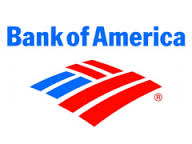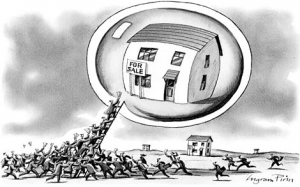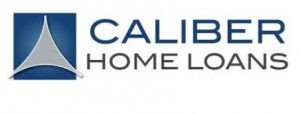by Jim the Realtor | May 19, 2017 | Jim's Take on the Market, Mortgage News, Mortgage Qualifying |

When the day comes that you hear the big banks pushing for reduced-doc loans, you’ll know that the top of the market is near:
http://www.reuters.com/article/us-bank-of-america-mortgages-idUSKCN18E37J
The head of Bank of America Corp, the United State’s fourth-biggest mortgage lender, said on Thursday banks would be able to supply a bigger share of funding for home purchases if the standard down payment for buyers was cut to 10 percent from 20 percent.
The vast majority of mortgages are underwritten to strict standards set by the U.S. government or quasi-government entities Fannie Mae and Freddie Mac. While down payment requirements can vary, they offer fairly little latitude to lenders that do not want to take all the risk themselves. As a result, many prospective homebuyers who cannot come up with a 20 percent down payment are unable to get a loan.
“Our goal – going back to regulatory reform – is should you move the down payment requirement from 20 percent to 10? It wouldn’t introduce that much risk but would actually help a lot of mortgages get done,” Chief Executive Officer Brian Moynihan told CNBC in an interview Thursday.
Bank of America was the top U.S. mortgage lender ahead of the 2008 mortgage crisis, causing it to face greater losses, both from defaults and litigation, than any other bank. Under Moynihan, who took the helm at the start of 2010, the bank has tightened lending standards and executives regularly use the motto “responsible growth” in public speeches.
Save
Save
by Jim the Realtor | Mar 27, 2017 | Boomer Liquidations, Boomers, CA Homeowners Bill of Rights, Foreclosures/REOs, Jim's Take on the Market, Loan Mods, Market Conditions, Mortgage News |

Our local home prices have risen so quickly that it feels like we’re in ‘bubble’ conditions again – could the bubble burst this time?
The last two times the real estate bubble has popped, it was due to banks having to offload their foreclosed properties for whatever the market will bear. They flooded the market, and buyers – and prices – backed off.
But that has all changed now.
Look at the new devices being used to avoid a flood of desperate selling:
- New accounting rules.
- California Homeowners Bill of Rights
- Reverse mortgages
The accounting rules were altered so banks could hold their REO properties longer, and the California Homeowners Bill of Rights has, in effect, stopped foreclosing. Lenders are now required to offer a loan modification to anyone in default, and only if the homeowner can’t or won’t qualify are they at risk of being foreclosed. With today’s higher rents, there isn’t much relief for those in default to give back their house and go lease one nearby. Besides, with our higher home values today, they can always sell before getting foreclosed.
Homeowners who need money can get a reverse mortgage too, as long as they haven’t been tapping into their equity already.
We end up with virtually no desperate sellers who need to dump on price. Someone who wants to cash out quickly can price their home at last year’s comps and look like a deal!
The game is rigged – the Banking Cartel won’t let the bubble pop again!
For the bubble to pop, we would need a dramatic shift in the supply and demand – either a flood of homes hit the market, and/or we run out of buyers.
I thought we’d be seeing more baby boomers unloading their homes due to downsizing or sickness, and while the market consists mainly of those listings, there aren’t enough of them to call it a flood – at least not yet. Because they are in quality locations, more kids are probably trying to buy out their siblings and take over their parents’ house, rather than sell it. They could be moving in with the folks too, rather than sending them to assisted living.
Could we run out of buyers? You would think there would be a price point where buyers can’t or won’t go any higher, but there seems to be a steady flow of people with more horsepower. We saw two weeks ago the prediction that the population of San Diego County is expected to grow by 700,000 people by 2050, which is over 21,000 per year – where are they going to live? Will they be rich? They will need to be!
There hasn’t been enough (has there been any?) sellers so desperate that they had to dump on price – instead, they just keep waiting. We would need more than a few price-dumpers to start a panic, which could cause the market to flood with supply and burst the bubble.
Some air might escape occasionally, but it is doubtful that a market change could occur without the government finding a way to save the bankers.
People like this guy think the conditions are ripe for a downturn. But if prices started falling, sellers are more likely to wait, than dump, which would cause our market to stagnate, rather than crash.
by Jim the Realtor | Mar 3, 2017 | Jim's Take on the Market, Mortgage News

Homeowners are opening their favorite piggy bank again — their homes.
As home values rise faster than expected, that increased homeowner wealth suddenly seems more enticing. It’s showing up in big remodeling growth and higher profits for retailers like Home Depot and Lowe’s, but it also serves as a warning sign.
Ever since the epic housing crash at the end of the last decade, homeowners have been extremely conservative with their home equity. Even those who had money in their homes kept it there, fearing another downturn in prices. Now, as millions of borrowers come up from underwater on their home loans and many more see their home values jump sizably on paper, borrowing more is back in favor.
Home equity lines of credit, known as HELOCs and often serving as second loans, allow homeowners to pull cash out of their homes when they need it. HELOC volume is now up 21 percent in the past two years, to the highest level since 2008, according to Moody’s. It is still nowhere near its housing boom level, when many people treated their homes like ATMs, but the trajectory is definitely pointing higher.
“The more second liens that people take out, it adds a risk that comes from the rising home prices. The fact that people are leveraging their homes more than before makes things more risky,” said Peter McNally, senior analyst at Moody’s.
Borrowers are also putting smaller down payments on home loans now, starting with less home equity either to save cash or because they can’t afford anything more. To put it in perspective, before the last housing boom, the median down payment was just over 7 percent. It then dropped to 3 percent during the height of the boom, as lenders offered all kinds of “creative” loan products that required little to no down payment.
After the crash, much of that lending became illegal and new rules made low down-payment loans more expensive to produce. As a result, down payments rose back above 7 percent again during the recovery. At the end of 2016, the median down payment had fallen to 6 percent, according to ATTOM Data Solutions, and it appears to be headed lower, as lenders offer more low down-payment products.
Read full article here:
http://www.cnbc.com/2017/03/03/more-homeowners-cashing-in-on-their-new-housing-wealth.html
Save
by Jim the Realtor | Feb 23, 2017 | Ideas/Solutions, Jim's Take on the Market, Mortgage News |

In the last downturn, there were a surprising amount of people who were underwater but hung on – and today with record-high prices, they are glad they did. We learned that whether you had equity or not, the chance of default was influenced by other factors. If that’s the case, lenders might as well finance the whole enchilada, and price in the same or similar percentage of defaults as last time.
http://www.housingwire.com/articles/39288-burkeyloan-to-offer-120-ltv-mortgage-that-also-pays-student-loans
BurkeyLoan launched its BurkeyLoan Mortgage division Tuesday which included its 120% loan-to-value mortgage product that funds both a home purchase and the borrower’s student loans.
BurkeyLoan, a portfolio mortgage lender, will issue, hold and service BurkeyLoan mortgages. The company’s 120% LTV product will allow Millennials to pay off or reduce their student loan debt in order to buy a home.
“After considerable research, review and analysis, we needed to build an access to capital product for the millennial generation,” BurkeyLoan Chairman and CEO John Burkey said. “Many millennials feel they are on a financial treadmill, making every effort to pay off student loans and save for a home while interest rates and home prices escalate.”
“Our mortgage product offers features and benefits that support the needs of the millennial generation,” Burkey said. “The company will utilize sound conservative underwriting that incorporates borrower credit, character, skin-in-the-game and risk mitigation.”
The program is available to community, regional and other banks as well as credit unions that broker residential mortgages.
But BurkeyLoan isn’t the first company to reach out to first time homebuyers struggling with student loans. Back in November, SoFi and the government-sponsored enterprise Fannie Mae announced a new loan option allowing homeowners to refinance their mortgage at a lower rate and pay down the balance of an existing student loan.
The average student graduates with just over $30,000 in student loan debt, according to the Institute for College Access and Success. The median home price increased to $228,900 in January, according to the National Association of Realtors. The new LTV 120% program may enable homebuyers to pay off the average student loan amount, while offering a change to invest in their housing.
by Jim the Realtor | Feb 23, 2017 | Fraud, Jim's Take on the Market, Mortgage News, Scams |

It happened to us – hackers got into somebody’s account.
They posed as the escrow officer and tried to divert my buyers’ down payment to the wrong bank account. Their timing was impeccable too.
Six days before closing, an email was sent to the buyers that looked like a normal email from the escrow officer:
Good morning (buyers’ names),
We are getting close to closing. It is important that we get the Cash to Close to avoid delays in closing.
Please tell me when you would wire the Cash to Close.
Regards, (escrow officer’s name)
The buyer asked for the amount and for wire instructions by email – and the hacker responded three times by email and even sounded like the escrow officer. This was the tip-off though:
Please find attached the wiring instructions. It is an account of one of our subsidiary company as our main account is currently undergoing compliance audit. As such, any funds entering the account would be held for review which would grossly affect the scheduled closing date. The total closing cost is X.
The hacker asked for an amount that was within $2,000 of being accurate, and if the buyers had been in a big hurry, they might have just sent it.
Thankfully, Mr. Buyer called the escrow officer direct to verify. The escrow officer was stunned – she hadn’t sent any emails to the buyers that day!
Because no crime was actually committed, the escrow, title, and mortgage companies just shrugged it off. We won’t ever know who the hackers were, or how they got in, but to call it unsettling is an under-statement.
From my buyer:
We felt very unnerved yet relieved. I couldn’t sleep that night, knowing how close we came to losing a substantial amount of money, by nearly anyone’s standards. I personally felt helpless, because I’m not sure what I could have done to recognize this fraud. We consider ourselves pretty plugged in and so we didn’t think twice about getting a wire request from escrow.
The bottom line is, escrow and bank request a lot of items and need responses ASAP so that escrow proceeds to a timely close. Therefore buyers are, in many cases, reading highly technical documents ‘on the fly’, often from smart phone screens. In my case, this meant that I was usually just skimming documents and electronically signing without really studying the material.
The escrow company did say in their instructions that buyers should call before wiring any funds. I didn’t notice this until after the attempted theft of our money. In the future, I would like to see escrow go back to speaking with buyers more often, instead of just emailing documents for signature. It sets a more personal tone and makes buyers more comfortable in picking up the phone to talk to the escrow agent with questions, rather than always relying on electronic communication.
Some escrow companies are now encrypting their wire instructions, but they are missing the point. The hackers are way ahead of us! All they need is a copy of the purchase contract (which agents, buyers, sellers, escrow and lenders email around unsecured), and the hackers can figure out the rest.
They just pose as the escrow officer a day early, and ask the buyers to wire the down payment and closing costs to them!
by Jim the Realtor | Jan 27, 2017 | Jim's Take on the Market, Mortgage News, Mortgage Qualifying |

The Gaylord-Hansen Team of Caliber Home Loans had a seminar yesterday to discuss the details of their mortgage of the future – and they have it now!
The goal is to make the obtaining of a mortgage completely digital, and gather the documentation needed to fund a loan without the borrower having to cough up loads of paperwork.
Here is how they’ve improved the requirements of getting a mortgage:
- Income from your tax returns has been verified with the IRS for years. But now Caliber not only pulls your income from the IRS, but they also conduct an automated cash flow analysis. If the computer says the borrower qualifies, no other underwriting is needed. Yes, we have had DU for years (designated underwriting), where the computer give the preliminary approval. But those are based on income that was inputted by the lender. With the new system, once the borrower has authorized the process, it goes untouched by human hands, making it fraud proof – a big plus!
- The borrower’s credit history is pulled from the three bureaus, and the credit behavior gets analyzed automatically. If the computer signs off, that’s it – no other human touch needed.
- Equifax and other companies do the employment verifications, where they contact your employer directly to verify that you still work there. Lenders usually handle those themselves, but much better to have a third-party be responsible.
- Your down payment/cash-to-close is verified automatically by Yodlee. The borrower is emailed a verification form that authorizes Yodlee to check the balances of your designated accounts automatically.
- If the automated appraisal system scores the house at 2.5 or under on a scale of 1-5, then no formal appraisal is required in person. The house may get looked at by satellite or drone to prove it’s still there.
- Everything from start to closing is signed electronically, and stamped by a virtual notary who pops up on your screen. They are using thumbprint verifications too, and anticipate going to retina scans.
- The funding of your loan can happen in eight days!
The mortgage underwriting process has always been the one-size-fits-all package, which wasn’t really fair to the best qualifiers. Now those borrowers with sterling histories won’t be dragged through the same rigors – instead, you are rewarded with speed and simplicity!
by Jim the Realtor | Dec 9, 2016 | Flips, Jim's Take on the Market, Mortgage News, Thinking of Selling?, Why You Should List With Jim |

We’ve touched on the new disrupter OpenDoor, which is currently operating in Phoenix and Dallas (places where home values might be easier to determine):
https://www.opendoor.com/homepage
They are willing to pay cash for your house and close in three days, which sounds enticing for those sellers looking for instant cash. But they offer to buy your home at a below-market price based on algorithms, and fees range from 6% to 12%. They are glorified flippers.
The length of time it takes to close escrow should have improved by now. It still takes 30-45 days to process a sale, which might be advantageous for sellers who occupy the home – they usually need time to pack it up.
But for those sellers of vacant homes, or those who want to use their proceeds to purchase another home, a quick escrow might be preferred.
Thankfully, there are new alternatives.
Quicken is offering the Rocket Mortgage, and yesterday Caliber Home Loans rolled out their new product that can close a regular sale in 10 days or less:
http://www.housingwire.com/articles/38710-first-look-caliber-home-loans-new-fully-digital-mortgage-will-close-in-10-days-or-less
These options should stop sellers from getting their head tore off just because they want a fast closing. These mortgage products could also really help the move-up market by alleviating the struggle of making offers contingent upon the sale of your current residence.
The regional VP of Caliber told me that their process is very innovative. They do not require the buyer to bring in the usual documents. Instead, they are getting them directly from the institutions themselves, which will help ensure accuracy. The IRS will furnish Caliber with income documentation, and the funds for closing will be verified directly with the banks themselves. The appraisals will be computer-generated in areas where you have easier valuations, like in Carmel Valley and Carlsbad where there are newer tract houses that are very similar.
We are close to being able to get a mortgage with the swipe of your ID card! It could invigorate the move-up market in 2017 – and Trump will get the credit!
by Jim the Realtor | Nov 8, 2016 | Jim's Take on the Market, Mortgage News, Mortgage Qualifying |

Changes this month by the California Housing Finance Authority will help more K-12 public school employees land their first home.
The Extra Credit Teacher Home Purchase Program — once restricted to teachers — is now available to all administrators and support staff such as aides, bus drivers and custodians in public schools, charter schools and district offices.
Education professionals can now receive down-payment assistance of up to $15,000 in “high-cost” counties such as Riverside and San Bernardino. The loan, at 2.5 percent interest, does not require payments until the home is sold, refinanced or the principal loan has been paid, explained finance authority spokesman Eric Johnson.
“People always think government programs are for low income people, but we’re really for low and moderate income residents,” Johnson said. “It’s the missing middle – people with good jobs who have sometimes been priced out of the housing market.”
Applicants must have a minimum credit score of 640. Those making more than $91,000 per year are excluded from the program. The home sales price cannot exceed $400,000.
Read full article here:
http://www.pe.com/articles/home-817823-riverside-teachers.html
CalHFA has several assistance programs:
http://www.calhfa.ca.gov/homebuyer/programs/
by Jim the Realtor | Nov 3, 2016 | Jim's Take on the Market, Mortgage News, Mortgage Qualifying |

Dropping the required owner-occupied ratio from 50% to 35% should open up more opportunities for condo buyers and sellers, but yes, the mortgage guidelines are getting easier and easier.
Owner occupied units are defined as principal residences, secondary residences, or units that have been sold to purchasers who intend to occupy them as a primary or secondary residence. A principal residence refers to a dwelling where the owner maintains or will maintain their permanent place of abode, and which the owner typically occupies or will occupy for the majority of the calendar year. A secondary residence refers to a dwelling that an owner occupies in addition to their principal residence, but less than a majority of the calendar year. A secondary residence does not include a vacation home.
Conditions to Lower Owner Occupancy Percentage to as low as 35 percent
Existing projects (greater than 12 months old) with an owner occupancy percentage of at least 35 percent and less than 50 percent are eligible for approval under the following circumstances and subject to the following conditions:
- Applications must be submitted for processing and review under the HUD Review and Approval Process (HRAP) option.
- Financial documents (see Section 2.1.6) must provide for funding of replacement reserves for capital expenditures and deferred maintenance in an account representing at least 20 percent of the budget; and
- No more than 10 percent of the total units can be in arrears (more than 60 days past due) on their condominium association fee payments (as defined in Section 2.1.5 of the Guide; and
- Three years of acceptable financial documents (see Section 2.1.6) must be provided.
http://portal.hud.gov/hudportal/documents/huddoc?id=16-15ml.pdf
by Jim the Realtor | Nov 2, 2016 | Jim's Take on the Market, Mortgage News |

What could go wrong?
http://www.housingwire.com/articles/38430-sofi-and-fannie-mae-announce-cash-out-refinance-student-loan-offering
Capitalizing off of its start as a student lender, SoFi and government-sponsored enterprise Fannie Mae announced a new loan option on Wednesday that allows homeowners to refinance their mortgage at a lower rate and pay down the balance of an existing student loan.
Under the new loan option, which is titled the Student Loan Payoff ReFi, SoFi stated that it will pay down the student loan by disbursing payment directly to the servicer of the student debt.
“People can pay off student loan debt and are left with one loan at the low rates that mortgage borrowers are enjoying in today’s market,” said Michael Tannenbaum, senior vice president of mortgage at SoFi.
Tannenbaum explained in an interview with HousingWire that there’s a big opportunity for borrowers to take out additional mortgage debt on their home thanks to the current low interest rate environment.
Typically, he said, student loans have a much higher rate than mortgages, making it better for borrowers to have more mortgage debt and pay off their student loans.













